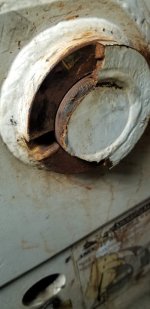deerefanatic
Aluminum
- Joined
- May 17, 2011
- Location
- Colon, MI
Hi all, I'm working on an IMT 16000 boom crane on a truck for the local lumber yard. needed a bunch of work including repinning and bushing the crane. The pins are hard chromed cylinder rod, that ride in Garmax synthetic bushings, so no grease. The haave a collar welded on one end that keeps them from rotating in the boom.
So to illistrate, if they fit together like this -=, the "inner" boom has the garmax bearings and the "outer" boom has anti-rotation knobs that keep the pin from rotating in it (as it's steel on steel). What we are finding is that the steel of the "outer" parts is worn, and new pins rattle around in them. I'm afraid if we put it back together, it will just pound the pins in short order. I'm thinking of line-boring and then rebushing down to size, but curious what sort of fit I should really be shooting for?
I've attached a picture of one of the original pins installed. As you can see, it got loose, and the anti-rotation collar broke.
So to illistrate, if they fit together like this -=, the "inner" boom has the garmax bearings and the "outer" boom has anti-rotation knobs that keep the pin from rotating in it (as it's steel on steel). What we are finding is that the steel of the "outer" parts is worn, and new pins rattle around in them. I'm afraid if we put it back together, it will just pound the pins in short order. I'm thinking of line-boring and then rebushing down to size, but curious what sort of fit I should really be shooting for?
I've attached a picture of one of the original pins installed. As you can see, it got loose, and the anti-rotation collar broke.


